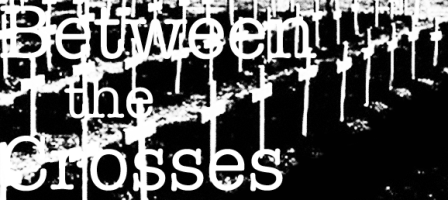The Riverfront Theatre, Newport
‘In Flanders fields the poppies blow / Between the crosses, row on row, / That mark our place; and in the sky / The larks, still bravely singing, fly’
The 1915 poem by John McCrae, giving this Flying Bridge Theatre production its title, commemorates the ‘Dead’, who once ‘lived, felt dawn, saw sunset glow’. Looking both towards and beyond it, this one-man play is as much about the survivor as it is about the dead. Namely, Edgar Huggins, a veteran of both the 1st Battle of Ypres and 2nd Battle of the Somme, and the last surviving member of the Durham Light Infantry.
 Edgar’s pronounced dialect crackles forth from the Imperial War Museum recording and he is a palpable presence in the room. It is around his voice that the account unfolds.
Edgar’s pronounced dialect crackles forth from the Imperial War Museum recording and he is a palpable presence in the room. It is around his voice that the account unfolds.
The script is a real strength. Will Huggins’ writing is informed and astute. Words written with historical balance and heart are, in turn, delivered with clarity and understanding. The part where Will Huggins essentially sums up the inconsistent Schlieffen Plan and international causes of the First World War in a three-minute breath is the best history lesson most of us have never had. Equally sharp is the 30-second, chalked diagram explanation of Army terminology that clarify Divisions from Brigades from Battalions from Companies. For these are the only absolute lines in this War. Beyond and within Ypres trench GHQ lines, the uncertain situation is one of dwindling ammunition, pitiful rations and chlorine gas, all under the belligerent observation of enemy balloons.
Yet Between the Crosses is minimalist in the excess. The set consists a cassette, cassette player, pile of papers, chair, a blackboard and some chalk. This simplicity is effective. It is also reflective of Edgar’s recount – understated and full of experiential gaps. Edgar’s words don’t corroborate school factoids that populate our minds. No tales of trenchfoot, shellshock and muddied corpses here. Instead, witnessing a man’s head severed by shrapnel is ‘second nature’, a shell-shocked soldier is a bit ‘crackers’ and the overall feeling is that of fellow men having ‘stood up very well’.
There is more afoot than stiff-upper-lip. The nature of memory and mismemory courses current. As a young boy sits with his great-uncle, the memories of a Norfolk-born boy who loved horses and dreamt of going to Australia unspool threadlike. The affinity with horses served Edgar well, but he never did make it to Australia. Instead this dream was subsumed by a conflict that lost the vitality of a generation. In relation, the pretty, church-like windows Edgar chooses to, or is able to, remember from Ypres tell us a great deal, about truth and remembering.
Those at home want to remember. The sacrificing dead are remembered most. Lesser, it can seem, is the honour bestowed upon those who have survived. Edgar’s own battalion roll call on the 1st May, one hundred years ago, counted 1000 men reduced to 200 in little time. Survival in this context comes with difficulties, weight and guilt.
The powdery chalk rubbed out from the blackboard at the end shows the audience in a physical way how time passes, dust remains. ‘We’re trying to understand,’ explains Will Huggins. Like almost all things in the performance, this too is done with a dignified timeliness and respect.ee
Between the Crosses will be showing at the Caerleon Arts Festival on 4th July www.caerleon-arts.org











